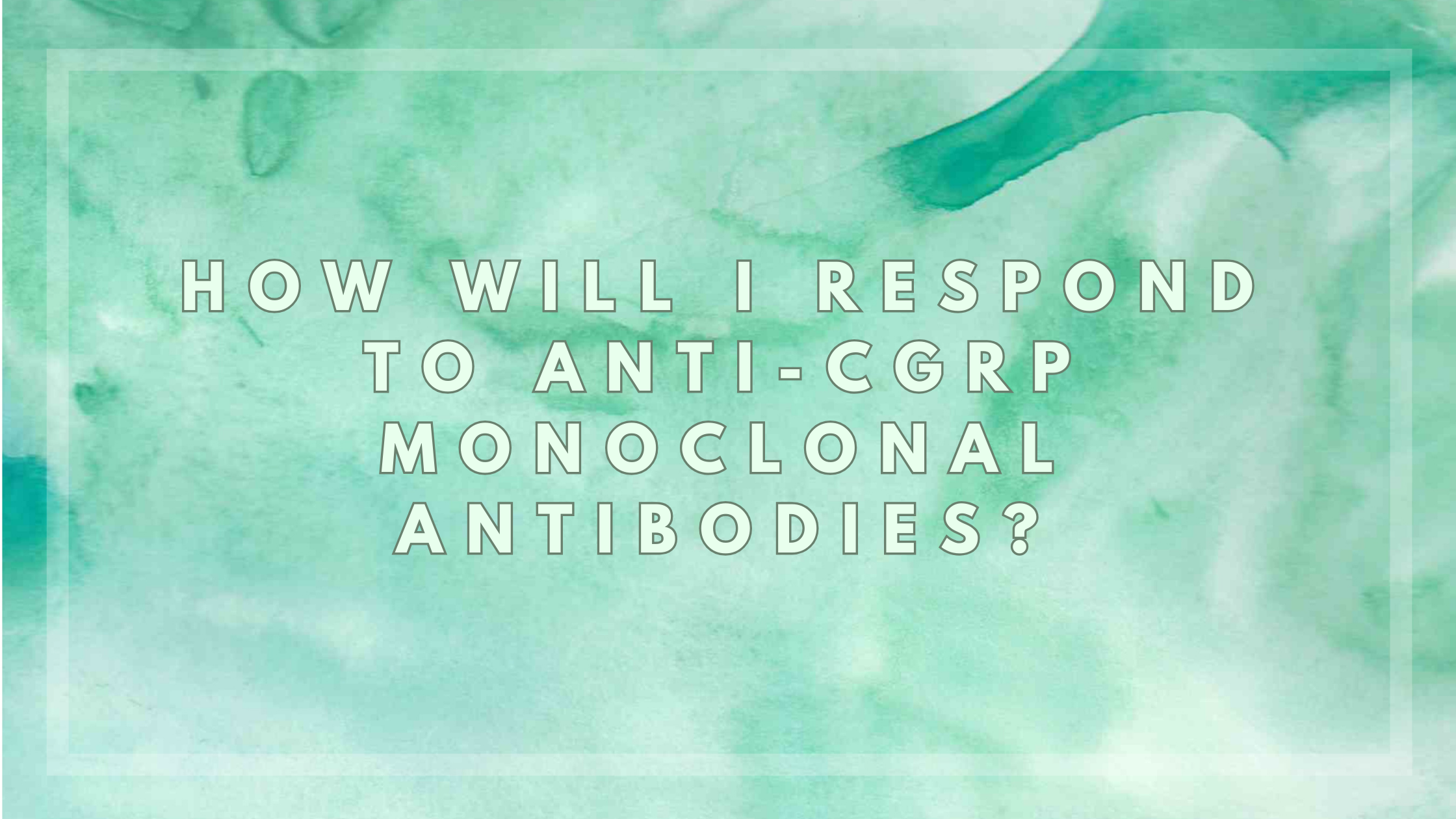Clinical Features VS Anti-CGRP Treatment Response
Posted on September 07 2023,

| Clinical Features | Anti-CGRP Monoclonal Antibody Response |
|---|---|
| Unilateral Headache | In two studies, unilateral headache was associated with better response to erenumab and galcanezumab [12, 13]. This may be because unilateral headaches are more typical of migraine. |
| Cranial Autonomic Symptoms | The presence of cranial autonomic symptoms during migraine attacks, such as ptosis, lacrimation, rhinorrhea, facial swelling, conjunctival injection, and pupil changes was linked to better outcomes with erenumab, fremanezumab, and galcanezumab in one study [14]. |
| Less Severe Disability | Two studies found that less disability at baseline, measured by the Migraine Disability Assessment (MIDAS), was associated with better response to erenumab [7, 15]. This could be because those with less disability have fewer factors contributing to their migraines. |
| Higher Baseline Migraine Frequency | In some studies, patients with a higher frequency of migraine days per month at baseline had better outcomes with erenumab [4, 12, 15]. This may be because they had more room for improvement with treatment. |
| Good Response to Triptans | A good response to triptan medications for acute migraine treatment was linked to better response to erenumab and galcanezumab in several studies [3, 13, 16]. This could suggest that these patients have migraine disease that is more typical and thus is more responsive to treatments targeting CGRP. More studies are needed. |
| Typical Migraine Features | One study found that super-responders to erenumab, fremanezumab, or galcanezumab were more likely to have typical migraine features like vomiting and good triptan response [3]. This aligns with the above predictors. |
| No Other Headache Types | The absence of other headache types besides migraine was associated with better erenumab outcome in two studies [4, 16]. Having only migraine may suggest a more specific, responsive condition. |
| Younger Age | One study linked younger age to better response to fremanezumab [9], possibly because younger patients have fewer comorbidities or less chronicity. |
| Higher CGRP-triggered Attack Susceptibility | Patients more susceptible to migraine attacks triggered by intravenous CGRP infusion had better outcomes with erenumab in one study [18]. This points to biology driving response. |
| Higher Pre-treatment Salivary CGRP | Higher salivary CGRP levels before treatment were associated with better erenumab response in one study [19]. This may indicate patients with higher CGRP involvement, who could benefit more from CGRP blockade. |
| Early Improvement in Disability or Frequency | A 50% or greater reduction in migraine disability per the MIDAS questionnaire or in monthly migraine days after 3 months of erenumab treatment was linked to better longer-term outcomes [17]. Early improvement may predict sustained response. |
| Increased Reflex Thresholds | In one study, increased thresholds of the biceps femoris withdrawal reflex after 3 months of erenumab predicted better outcomes [20]. This may reflect anti-nociceptive effects correlating with efficacy. |
| Decreased Serum CGRP | While pre-treatment serum CGRP did not predict response, lower CGRP levels after 4 weeks of erenumab did associate with better outcomes in one trial [21]. This suggests patients had better CGRP blockade. |
| Less Iron Accumulation on MRI | One study found patients with less iron accumulation in certain brain regions on MRI after 8 weeks of erenumab were more likely to respond [22]. The reasons for this correlation are still uncertain. |
| Chronic Migraine | Having chronic rather than episodic migraine was linked to lower response rates to erenumab, fremanezumab, and galcanezumab in some studies [1, 3], possibly due to greater disease severity and comorbidities in chronic migraine. |
| Continuous Headache | Chronic migraine patients with continuous, unremitting headache were found to have poor outcomes with erenumab in multiple studies [1, 2, 4, 5, 10]. This very refractory subtype may have different biology and requires specialized treatment approaches. |
| Medication Overuse/Adaptation | Medication overuse/adaptation headache was more prevalent among non-responders than super-responders in one study [3], and associated with poorer outcomes in others [6, 7]. Detoxification may improve results in these patients. |
| Comorbid Depression | One study found depression was more common in erenumab/fremanezumab/galcanezumab non-responders, suggesting psychiatric comorbidity may reduce treatment response [3]. |
| Multiple Previous Treatment Failures | Having failed multiple previous preventive medications negatively correlated with erenumab response in some analyses [1, 4, 6, 7]. This likely indicates more refractory disease. |
| Higher Baseline Migraine Frequency | Despite the above association, higher baseline migraine days also predicted poorer erenumab response in some studies [4, 8]. This may point to more severe, resistant illness. |
| Interictal Allodynia | The presence of allodynia between attacks was linked to lower galcanezumab response in one trial [11], perhaps signifying maladaptive neuroplasticity less amenable to CGRP blockade. |
References:
[1] https://www.frontiersin.org/articles/10.3389/fneur.2021.805334
[2] https://headachejournal.onlinelibrary.wiley.com/doi/10.1111/head.13951
[3] https://link.springer.com/article/10.1007/s10194-022-01552-x
[4] https://journals.sagepub.com/doi/full/10.1177/03331024211228185
[5] https://link.springer.com/article/10.1007/s10194-022-01456-2
[6] https://link.springer.com/article/10.1007/s42399-021-00904-8
[7] https://link.springer.com/article/10.1186/s10194-021-01267-x
[8] https://onlinelibrary.wiley.com/doi/10.1111/ane.13472
[9] https://link.springer.com/article/10.1186/s10194-022-01396-x
[10] https://journals.sagepub.com/doi/10.1177/03331024211048765
[11] https://journals.sagepub.com/doi/10.1177/03331024221147881
[12] https://onlinelibrary.wiley.com/doi/full/10.1111/head.14032
[13] https://onlinelibrary.wiley.com/doi/10.1111/ene.15197
[14] https://link.springer.com/article/10.1007/s10072-020-05022-z
[15] https://www.frontiersin.org/articles/10.3389/fneur.2021.10523
[16] https://journals.sagepub.com/doi/10.1177/25158163211026646
[17] https://link.springer.com/article/10.1186/s10194-022-01480-2
[18] https://link.springer.com/article/10.1186/s10194-018-0927-2
[19] https://onlinelibrary.wiley.com/doi/full/10.1002/ana.26472
[20] https://journals.sagepub.com/doi/10.1177/0333102420942230
[21] https://link.springer.com/article/10.1007/s00415-022-11183-z
[22] https://journals.sagepub.com/doi/10.1177/03331024221144783
Tue, Mar 11, 25
Biofeedback Types for Migraine Treatment
Biofeedback is a non-invasive, non-pharmacological approach that enables individuals to gain control over physiological processes linked to migraine, such as muscle tension, blood flow, and brain activity. Using monitoring equipment,...
Read MoreMon, Mar 10, 25
Chronic Pain Conditions Associated with Migraine
Chronic Pain Conditions Associated with Migraine Condition Description Association with Migraine References Irritable Bowel Syndrome (IBS) A functional gastrointestinal disorder characterized by abdominal pain and altered bowel habits. Higher prevalence...
Read More


